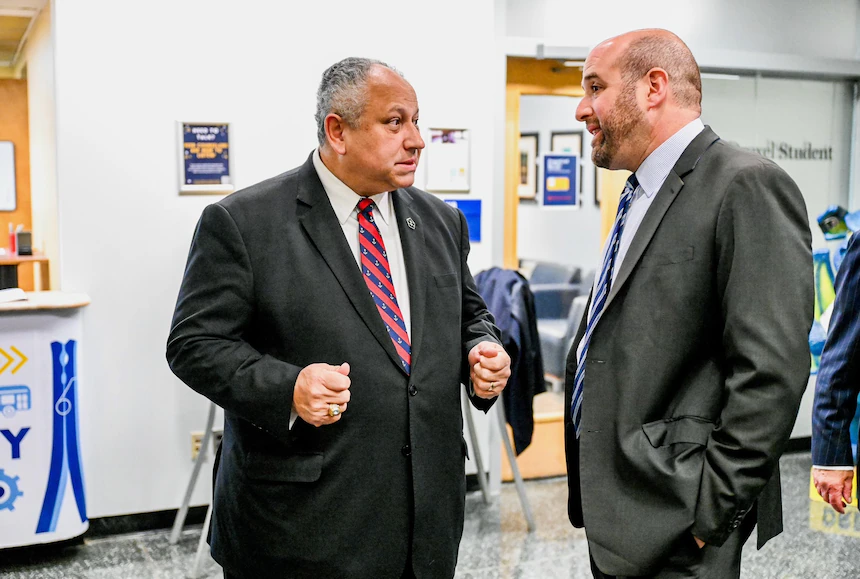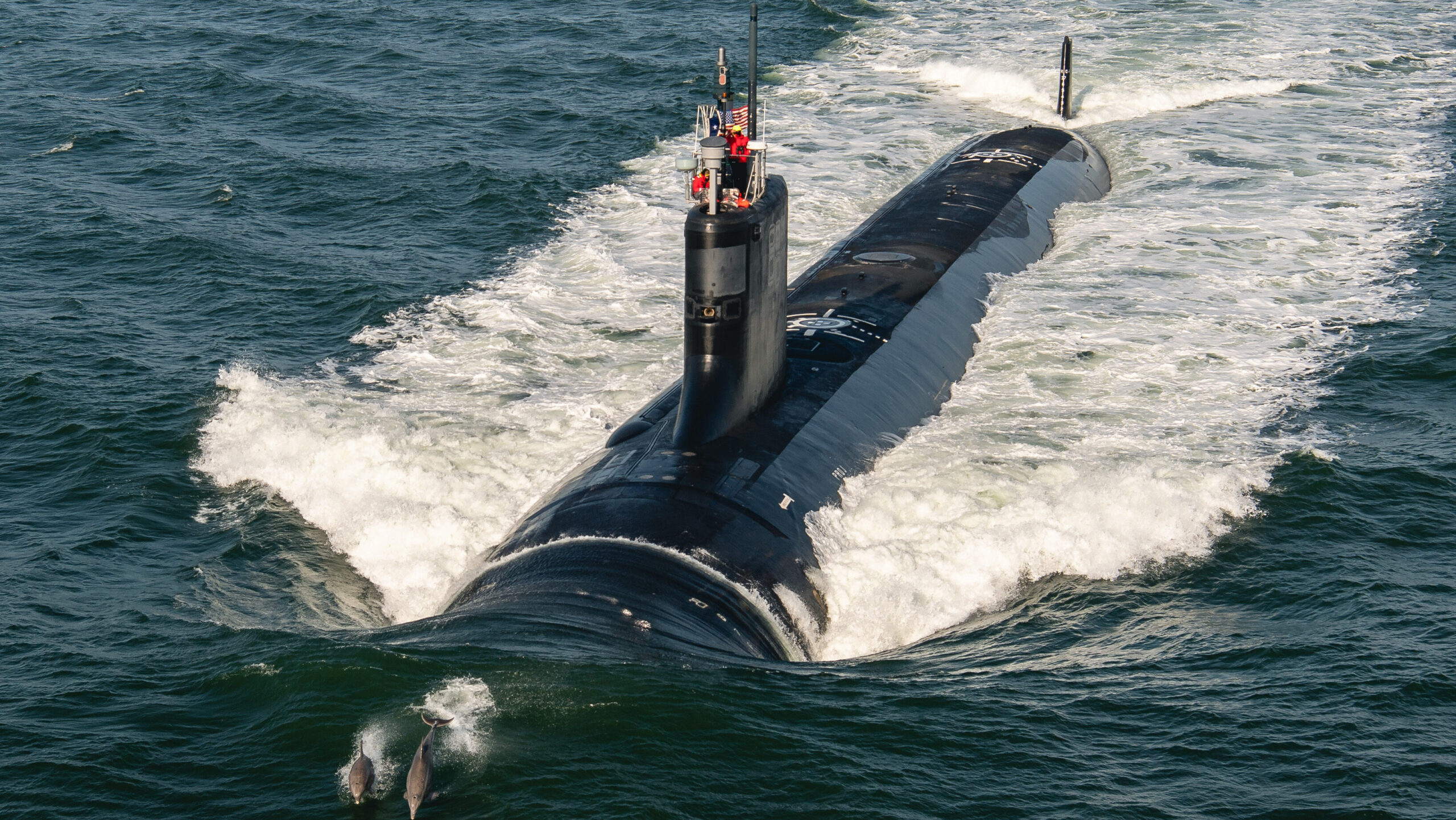US Secretary of the Navy Carlos Del Toro urged industry and academia to join efforts to restore the Nation’s competitive shipbuilding and repair landscape (Photo Credit: US Navy)
Good morning, everyone! It’s wonderful to be here with you this morning at Drexel University for the Naval Nuclear Submarine and Aircraft Carrier Suppliers Conference.
Thank you, President Reynolds, for the warm welcome and for your leadership of the Delaware Valley Chapter of the National Defense Industrial Association. I look forward to continuing to work together in the future.
I want to express my gratitude to all of you—your support and dedication to our nation’s maritime power is invaluable to our efforts, and I commend you for it.
I especially want to thank Governor Shapiro for his partnership on our initiatives—and his support in investing significant public dollars from Commonwealth of Pennsylvania.
Secretary Siger, thank you for being here. Your leadership of the Pennsylvania Department of Community and Economic Development has been an essential catalyst for this gathering.
Secretary Walker, thank you for joining us today—your work at the Pennsylvania Department of Labor and Industry has also been a boon to our efforts to partner at the state level and with industry here in the Keystone State.
Pennsylvania truly is a model for the future of our partnership efforts with state and local governments across the nation as we endeavor to revitalize our industrial base.
Your investments in critical infrastructure improvements and workforce training are making a tremendous impact on our ability to change the narrative about what American industrial innovation can accomplish.
Vice President Keech, many thanks to you and to Drexel University for hosting us for this fantastic event. The innovation and ingenuity of your scientific and technical researchers are fundamental to giving our industrial base the tools necessary to accelerate our strategic advantage.
Two months ago, I called for a new maritime statecraft—to emphasize building our comprehensive national maritime power.
This effort requires a whole of government—indeed, a whole of enterprise—approach.
The renowned naval strategist, Alfred Thayer Mahan, argued that naval power leads to commercial maritime power, which in turn fuels further naval growth.
China’s leadership has clearly studied and embraced this theory.
Today, China dominates the global commercial shipbuilding industry, with over 40% of the market controlled by its shipyards.
In just 20 years, the PLA Navy has tripled in size, and it’s projected to have a fleet of over 400 warships by 2030.
With the world’s largest fishing fleet and third largest merchant marine fleet, exceeding 7,000 ships compared to the United States’ 178 (ranking 70th), China controls a significant portion of the global commercial maritime supply chain.
This creates substantial operational and economic risks for the American economy in the event of a crisis or conflict.
Over the past three decades, while China’s comprehensive maritime power has skyrocketed, ours has dramatically declined.
History demonstrates a clear pattern: no great naval power has ever existed without also being a dominant commercial maritime power, encompassing both shipbuilding and global shipping.
It is imperative that we take decisive action to reclaim America’s position as a leading maritime power.
This requires a multi-pronged approach, including: investing in the revitalization of our shipbuilding industry and merchant marine fleet, developing innovative technologies to maintain our naval edge, strengthening partnerships with key allies to counter China’s growing influence, and promoting fair competition.
One month ago, I convened the first meeting of the Government Shipbuilder Council, a key part of that effort.
Four cabinet departments—Defense, Transportation, Homeland Security, and Commerce—and five shipbuilding organizations—including Army—came together to identify what actions we need to take to build the strength and readiness of our respective fleets.
We all shared concern that our position as the world’s leading shipbuilder has dissipated over the past four decades, and we, as a nation, have exposed ourselves to vulnerabilities in shipbuilding, sealift, and economic trade.
Through open discussions and shared commitment, we reached a clear consensus: we must tackle these challenges head-on, as a united front.
We know that far too few outside our maritime circles recognize or acknowledge these risks—risks we can no longer afford to take in the face of intense competition with a full-spectrum global maritime power.
Collectively, we have what it takes to restore our Nation’s competitive shipbuilding and repair landscape—including private and public investments in world-class manufacturing and shipbuilding facilities—and the highly-skilled workforce necessary to keep them running.
While the vision is ambitious, it is achievable. We are a nation accustomed to taking on ambitious endeavors, and restoring our maritime strength is no exception.
Our nation’s security and economic prosperity depend on a robust maritime industry.
Public and private investments, alongside strategic statecraft, are key to attracting private capital and making this vision a reality.
This cannot be just a federal government endeavor. It requires partnership with centers of maritime industry at the state and local level—and with all of you here today.
This will undoubtedly be a long-term effort. But as I always say, you have to take the first step or else you will never get there.
I’m here at this conference today because I believe in the potential of our joint efforts to get shipbuilding and maintenance right—indeed, it is my number one priority.
We in the government will not reach our goals or succeed in our mission without your help. We rely on the invaluable support of industry and academia.
Your expertise, time, and resources are essential for developing the cutting-edge technologies that will secure our maritime dominance.
In fact, several commands, including ONR and NavalX, are here today, collaborating with industry and our Drexel hosts to identify and address capability gaps.
As a former small business owner, I understand the importance of a strong business case for investment.
I believe the Department of the Navy’s commitment to innovation and rapid technology development presents an attractive opportunity for industry participation.
Pennsylvania alone boasts over 570 vital submarine industrial base suppliers, 39 of which are classified as critical. In just the past five years, we’ve invested over $250 million to build capacity, increase capability, and add resiliency to these suppliers.
Fiscal Year 2023 was a groundbreaking year for investments and contractor awards to our industrial base.
I’m particularly proud we added 1,000 new small businesses by investing nearly $2 billion through initiatives led by our Office of Small Business Programs to our Navy-industry team—many of whom are here today.
Now, the key is to help us all find and train the right people—and our Talent Pipeline Initiative has been instrumental in addressing workforce shortages.
Philadelphia was the first location for our pilot program—it has since expanded to Pittsburgh and other locations, all modeled on our efforts here.
Since its launch in 2021, this initiative has placed over 1,200 skilled workers with Pennsylvania suppliers, with over 698 placed in fiscal year 2023 alone.
We are also committed to expanding apprenticeship programs, as evidenced by the recent reinstatement of the Philadelphia Shipyard’s program—previously suspended since 2017—currently training over 100 workers.
Partially through our efforts, the Philadelphia Shipyard has grown from around 300 employees to well over 2,000—and has a catalogue of ships under construction and under contract—most notably, Maritime Administration’s National Security Multi-Mission Vessel.
And the Commonwealth of Pennsylvania has also stepped up with its own investments in infrastructure at many of our suppliers.
The Americans who build and maintain all of our ships are a national asset, and we must be relentless in our efforts to improve their number, capabilities, and skill.
High-paying, high-skilled “new-collar” jobs that restore America’s manufacturing prowess are a priority of this Administration, combining traditionally blue-collar trades with cutting-edge technologies.
We must establish programs that build capacity in fields like naval architecture, engineering, and lifecycle management, as well as technical expertise in nuclear welding, robotics, software management, and additive manufacturing.
We’re going to need 150,000 new qualified workers in the next ten years—pre-apprenticeship, registered apprenticeship, and labor management programs are critical tools to help fulfill this labor demand.
Your work on these programs will be invaluable to developing and rebuilding our nation’s shipbuilding landscape.
As we’re developing these skillsets throughout our shipbuilding workforce, we must continue to leverage our nation’s advantage in technology and innovation in the maritime domain.
Agility in ship production and design requires developing new, digital tools for our workforce to improve efficiency and capacity.
The future of shipbuilding, maintenance, and repair looks much different than it did when I retired from the Navy twenty years ago—advances in modelling, virtual reality, and artificial intelligence will allow us to reduce costs, optimize systems, and improve collaboration across all stakeholders.
I want to acknowledge the remarkable achievements we’ve made together during my tenure as Secretary of the Navy. These successes are a testament to the collective efforts of the Department of the Navy, industry partners, and many of you present here today.
The largest instrument of American naval power—USS Gerald R. Ford (CVN 78)—has been on her first operational deployment for the past eight months.
She’s been defending our national security interests, and most recently, deterring our adversaries from escalating the conflict in Israel from the Eastern Mediterranean.
She recently reached the incredible milestone of having completed over 20,000 launches and recoveries since her delivery—and the nukes on my staff insist none of that would be possible without “hot rocks making steam.”
That achievement is a testament to the drive and dedication, not just of her crew, but of everyone involved in her construction, training, operations, and certification—Sailor, civilian, contractor, shipbuilder, and supplier.
Today, the next ship in the Ford-class, USS John F. Kennedy (CVN 79), is more than 90% complete, too.
As you know, in addition to Ford-class carriers, we’re building Columbia-class ballistic missile submarines—my department’s number one acquisition priority—and Virginia-class submarines.
The Virginia-class serves as the backbone of our fast attack submarine fleet, and are at the heart of the trilateral AUKUS partnership.
The historic AUKUS trilateral agreement between Australia, the United Kingdom, and the United States represents a significant step forward in deterring global threats and maintaining maritime stability.
AUKUS will provide Australia with a conventionally-armed, nuclear-powered attack submarine, enhancing regional security and demonstrating our enduring commitment to our allies.
This partnership presents us with exciting opportunities in the shipbuilding and maintenance sector.
We will be working closely with our Australian counterparts to ensure they have the resources and expertise needed to operate and maintain their new submarines.
The success of AUKUS will require collaboration and commitment from industry partners like you. Your expertise and innovation will be crucial in ensuring the success of this historic partnership.
We’re encouraged that the National Defense Authorization Act for Fiscal Year 2024 released last week includes our requested AUKUS legislative proposals—they will keep AUKUS on pace and allow for the receipt of three billion dollars of Australian funds into our domestic Submarine Industrial Base.
I’m sure you’ll learn more about this investment later this afternoon as you hear from our newly-confirmed and soon-to-be-admiral, Captain Lincoln Reifsteick. Captain Reifsteick—congratulations on your impending promotion next week—it is well-deserved, and we look forward to your continued service in our Navy.
Additionally, and separately from AUKUS, we are working with Congress to pass a supplemental funding package that includes nearly three and a half billion dollars to further bolster our Submarine Industrial Base.
Our Sailors, Marines, Soldiers, Airmen, Guardians, and Coast Guardsmen deserve the best equipment and resources.
We must ensure their success through enduring commitments from the Department of Defense, Congress, industry, and the American people.
We are in an innovation race—and it is one we must win.
Innovation must permeate every aspect of our approach to the delivery of the technologies and capabilities at a speed and scale necessary for our Navy and Marine Corps to confront the challenges of today and the future.
President Biden was here in July to discuss this administration’s efforts to revitalize American manufacturing.
As some of you may know, I’ve helped catalyze a first-of-its-kind, White House-led effort on the shipbuilding industrial base.
Everyone here has a part to play in these efforts—and it is a strategic imperative that we rise to the occasion.
Now, I’d like to hear from you. No question is off-limits. Your feedback and insights are invaluable as we move forward together.
Thank you for your dedication and service to our nation. May God continue to grant fair winds and following seas to our Sailors, Marines, Civilians, and their families.
The above text was originally published by US Navy on 14 December 2023.




